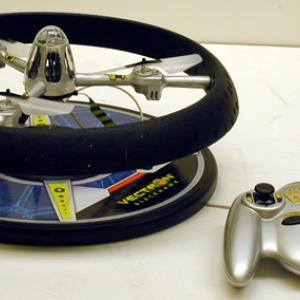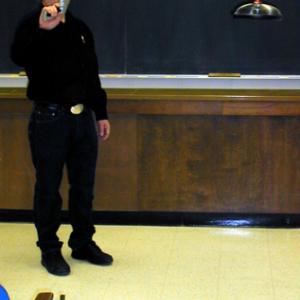College of Liberal Arts & Sciences
10C10.50 - Vectron and Drones
Seel also 6J11.31 in Optics.
This device shows several high tech principles. The first of these is rotational stability. As you can see in the movie when the device is started it spins. The spin gives it a very stable flight.
To allow the ring to move left or right or back and forth very fine control of the motors is required. The control console is used as the point of reference. If we want the ring to go to the right then every motor that spins around to the right side of the ring must slow slightly relative to the other motors.
Another high tech part of this device is the LED advertising billboard. Basically there is a single strip of LED that is flashed at the appropriate time when the ring is spinning. This flashing combined with the eyes' persistence of vision allows you to see words.
The Vectron Ultralite is a version of the original Vectron that is much simpler to use. There is no tether and no lateral control, only controls for up and down. The toy will move according to the currents in the lecture room.
NOTE: Works best in a room with flat ceilings no higher than ten foot.
The vectron can be also used for the Skywriter demonstration 6J11.31.
- Chadwick Young, John Dennis, Kaisa Young, Himanshu Verma, "Using Drones in a First-Year Physics Lab", TPT, Vol. 62, #3, March 2024, p. 182.
- William H. Baird, Benjamin Kersker, Clifford Padgett, and Jeffery Secrest, "Quadcopter Flights in a Variety of Atmospheres", TPT, Vol. 58, #2, Feb. 2020, p. 101.
- Eric Ayars, Tori Goff, and Kirk Williams, "Things One Can Learn by Putting a Quadcopter in a Vacuum Chamber", TPT, Vol. 56, #5, May 2018, p. 317.
- Yasuo Ogawara, "Teaching F=ma Using a Flying Saucer Toy", TPT, Vol. 49, #2, Feb. 2011, p. 119.
Disclaimer: These demonstrations are provided only for illustrative use by persons affiliated with The University of Iowa and only under the direction of a trained instructor or physicist. The University of Iowa is not responsible for demonstrations performed by those using their own equipment or who choose to use this reference material for their own purpose. The demonstrations included here are within the public domain and can be found in materials contained in libraries, bookstores, and through electronic sources. Performing all or any portion of any of these demonstrations, with or without revisions not depicted here entails inherent risks. These risks include, without limitation, bodily injury (and possibly death), including risks to health that may be temporary or permanent and that may exacerbate a pre-existing medical condition; and property loss or damage. Anyone performing any part of these demonstrations, even with revisions, knowingly and voluntarily assumes all risks associated with them.

